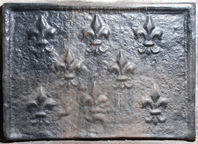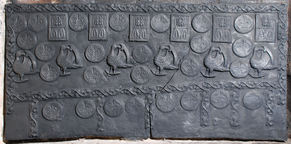-
73
Description: Plain rectangular plate; print of a left hand, lower centre.
Notes: The excrescence above and to the left of the hand print shows where the pouring iron displaced the casting sand.
- Decoration tags:
- rectangular (shape)
- none (edging)
- simple stamps
- humans
Manufactured: in the 16th century in the Weald area of England.
Current location: in private hands, Groombridge, Kent, England.
- Attached to series:
- Hand print firebacks
-
75
Description: Rectangular; ovolo moulded edging (top and sides); 14 impressions of a fleur de lys, arranged in three horizontal rows (5-4-5), carefully spaced.
Notes: The same fleur de lys stamp has been noted on several firebacks, indicating a common source.
- Decoration tags:
- rectangular (shape)
- ovolo (edging)
- carved stamps
- heraldic
Manufactured: in the mid- to late-16th century possibly at Pounsley Furnace, Framfield in the Weald area of England.
Current location: in private hands, Groombridge, East Sussex, England.
- Attached to series:
- Pounsley series
-
1226
Description: Rectangular; rope edging (top & sides); in centre, Tudor shield, garter, crown and supporters (greyhound and lion) between two fleurs-de-lys; date top left.
Notes: A badly corroded fireback. The armorial achievement is seen on other firebacks and was formed from four separate stamps; the supporters are consistent with the date; the style of the numerals is uncharacteristic of the period. The sharpness of the detail on the crown and upper part of the Garter indicates that the fireback is contemporary with the date, and not older as similar examples seem to be. The same date in identical form is on a similar fireback at Penshurst Place, Kent.
Inscription: 1579 / [Garter motto incomplete]
Arms: Tudor royal
- Decoration tags:
- rectangular (shape)
- rope (edging)
- carved stamps
- date stamp
- heraldic
- armorial
- text
- animals
Manufactured: in 1579 in the Weald area of England.
Current location: Groombridge Place, Speldhurst, Kent, England.
- Attached to series:
- Tudor redated series
- Pounsley series
- Tudor royal armorial firebacks
-
306
Description: Rectangular; twisted rope edging (top and sides) with a fillet inside; top centre, concentric roundel with rose-and-crown below; top left, initials in triad with small rose below 'W' and small fleur-de-lys below 'M'; upper right, date with small fleur below '6' and small rose lower, below second '7'.
Notes: The style of rose and crown is similar to that used in gun founding in the Tudor period, suggesting that the furnace that was the source of this fireback may have been used for that purpose.
Inscription: WLM [triad] 1677
- Decoration tags:
- rectangular (shape)
- rope (edging)
- carved stamps
- individual letters
- individual numbers
- heraldic
- text
- objects
Manufactured: in 1677 in the Weald area of England.
Current location: in private hands, Speldhurst, Kent, England.
- Attached to series:
- 1660s-90s Wealden series
- Fleur-de-lys firebacks
-
78
Description: Sub-rectangular; twisted rope edging; lengths of twisted rope arranged to form two 'V' shapes and an 'I' overlapping to forma possible monogram.
Notes: The 'monogram' comprises different length pieces of rope and may have an apotropaic significance, the double 'V' referring to the Virgin Mary.
- Decoration tags:
- rectangular (shape)
- rope (edging)
- simple stamps
- apotropaic
- objects
Manufactured: in the 16th century in the Weald area of England.
Current location: Guildford Museum, Guildford, Surrey, England.
Museum number: G.488 (part of the Guildford Museum museum group)
- Attached to series:
- Rope design firebacks
-
85
Description: Rectangular; twisted rope edging; twisted rope arranged to form inscription across upper half of plate.
Notes: The double 'v' may have an apotropaic significance, invoking the Virgin Mary.
Inscription: +W+
- Decoration tags:
- rectangular (shape)
- rope (edging)
- simple stamps
- apotropaic
- objects
Manufactured: in the mid- to late-16th century possibly in the Weald area of England.
Current location: in private hands, Hadlow Down, East Sussex, England.
- Attached to series:
- Rope design firebacks
-
91
Description: Rectangular; twisted rope edging (top and sides); narrow top panel and two narrow side panels, each separated by twisted rope; top panel with symmetrical inscription line begun and ended with a stamp formed of four spots in square, the same stamps separating the date, each of the initials and a central rose stamp, the date being repeated at each end; plain side panels; central panel comprising three shields bearing a rose and crown, one on the top line between two rectangles, each bearing a griffin passant, and two shields on the ends of the lower line with two rectangles with griffins between, the bottom half of the plate is plain.
Notes: The shield and griffin stamps appear on two firebacks at Hastings Museum, in each of which the shields are inverted.
Inscription: 1569 HB AB 1569
- Decoration tags:
- rectangular (shape)
- rope (edging)
- simple stamps
- carved stamps
- individual letters
- individual numbers
- heraldic
- text
- animals
- plants
Manufactured: in 1569 in the Weald area of England.
Current location: in private hands, Hadlow Down, East Sussex, England.
- Attached to series:
- Griffin series
-
1006
Description: Rectangular shape with twisted rope edging (top and sides); date split between top corners.
Notes: The central button on the number 1 is consistent with a date in the first half of the seventeenth century. Hall's auction, Shrewsbury, 28 Oct 2015, lot 127 (£190).
Inscription: 16 37
- Decoration tags:
- rectangular (shape)
- rope (edging)
- individual numbers
- text
Manufactured: in 1637 possibly in the Shropshire area of England.
Current location: in private hands, Wigmore, Herefordshire, England.
- Attached to series:
- Date only firebacks
-
90
Description: Rectangular; ovolo moulded edging (top and sides); eight impressions of a fleur de lys, arranged in three horizontal rows (3-2-3), carefully spaced.
Notes: The same fleur de lys stamp has been noted on several firebacks, indicating a common source.
Copies of this fireback are known.
- Decoration tags:
- rectangular (shape)
- ovolo (edging)
- carved stamps
- heraldic
- objects
Manufactured: in the mid- to late-16th century possibly at Pounsley Furnace, Framfield in the Weald area of England.
Current location: Hampton Court, Richmond, Greater London, England.
(part of the Royal Collection museum group)
- Attached to series:
- Pounsley series
- Fleur-de-lys firebacks
-
96
Description: Rectangular; undulating vine tendril edging (top and upper sides); eight circular, fleur-de-lys butter mould stamps alternating (except at left end) with six rectangular, fleur-de-lys and leaf shortbread or gingerbread stamps, in a line along the top; six bird stamps (wings displayed and inverted) alternating with five pairs of butter mould stamps, as above; continuous line of horizontal vine strips; six descending vine strips, interspaced unevenly with eight butter mould stamps, in pairs except for rightmost two.
Notes: The bird (probably a swan, a Lancastrian badge) and vine strip stamps are encountered on several firebacks. In 1868 this fireback was recorded at Tickeridge, West Hoathly, Sussex.
- Decoration tags:
- rectangular (shape)
- trailing vine (edging)
- simple stamps
- carved stamps
- animals
- plants
- objects
Manufactured: in the mid- to late-16th century possibly at Pounsley Furnace, Framfield in the Weald area of England.
Current location: Nymans, Staplefield Road, Handcross, Slaugham, West Sussex, England.
Museum number: 1206011 (part of the National Trust museum group)
Citation: Stenning, J. C., 1868, 'Notes on East-Grinstead', Sussex Archaeological Collections, 20, pp. 151-2.


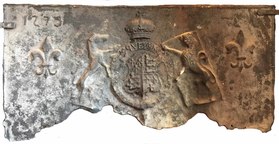
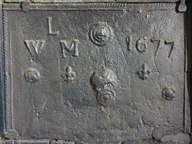
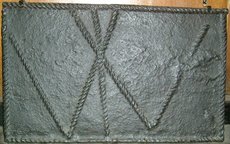
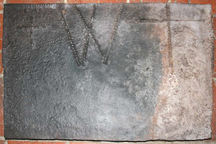
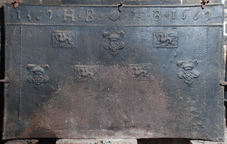
,_lot_127_28_oct_2015a.jpg)
